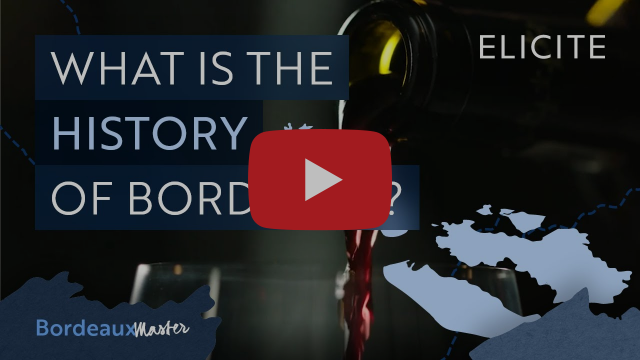Bordeaux, France is one of the most well known wine regions in the entire world, and its influence in viticulture, winemaking, and palates make it one of the most important, as well. So let's get a little history about this place, and see what their wines are all about.
Bordeaux was a popular neighborhood for Neaderthals between 30,000 to 20,000 years ago, and you can still visit one of their caves called Pair-non-Pair ►. Around 300 BCE it was settled by the Celtic tribe Bituriges Vivisci, and they named the town Burdigala. Its location at the meeting of the Gironde and Bordogne rivers made it a great center for trade, so it allowed them to get all kinds of rich, especially through canal tolls and taxes. It came under Roman rule around 60 BCE and we all know that wherever the Romans went, vineyards went too.
(This article was written for GrapeBunch, our weekly wine periodical. Click here to read the original!)
(This article was written for GrapeBunch, our weekly wine periodical. Click here to read the original!)
The story of what we know as Bordeaux wine today starts in the 1150's CE when the Queen of France and Bordeaux native, Eleanor of Aquitaine, married the very-soon-to-be King of England, Henry II. From here on out the English would be the main consumer and the biggest source of influence for the wines of Bordeaux. Because of this lucrative export, the city's success and development boomed. Its wine knowledge and innovation accelerated beyond others of the time.
Bordeaux would become world famous for the quality and prestige of its wine, and wine producing regions in other countries would imitate their processes to achieve that quality. For example: the outstanding wines of Rioja, Spain would not be what they are today without what they learned from Bordeaux. Thomas Jefferson, Founding Father and America's first wine connoisseur, was a huuuuuuge Bordeaux fan.
One of the biggest moments in Bordeaux history is what is known as the Classification of 1855 ►. Napoleon III requested that a classification system would be created so he could show off the best Bordeaux wines during the very first Exposition Universelle, a world's fair held in Paris. Well, initially the responsibility was left to the chateaux to decide the best of the best, and they refused to rank their neighbors, friends, and nemisis. So the system was based on the price of their wine at the time instead, and the chateaux were separated into five tiers, from "First Growth" to "Fifth Growth". All of these wines were from the Left Bank and none from the Right Bank, which we'll go over soon. The classification has only changed once, when a Second Growth was elevated into First Growth in 1973 after decades of lobbying. Other than that, the Classification of 1855 remains in stone.
For the red wines of Bordeaux they can only use six different grapes to blend with: Cabernet Sauvignon, Cabernet Franc, Carménère, Malbec, Merlot, and Petit Verdot. For white wines they can use Sauvignon Blanc, Sémillon, and Muscatel. The reason for using these varieties is not just because they taste good when blended and contribute different qualities, but also because their vines bud and their grapes ripen at different times. This gives them options if weather is being difficult at any given time. If it was a bad growing season for Malbec, use more Petit Verdot in the blend instead.
So I mentioned Left Bank and Right Bank earlier, but what does this mean? Simply put: Left Bank is the west side of the Gironde River, and the Right Bank is the east side of the Gironde River and north of the Bordogne River. The wine region on the east of the Gironde and south of the Bordogne is called Entre-Duex-Mers and mostly produces value table wine. But the difference between Left Bank and Right Bank isn't just location. It can also refer to a style of wine, and that's because of that location.
The Right Bank came first. The soil here is limestone with muddy marl, which is a combination of loam and clay. This very much pleases the Merlot vine, cooling its fruit from the ground. Thus, the Right Bank style of red wine is Merlot based, and is generally rich with dark fruit and soft tannin. The Left Bank used to be salt marshes until the Dutch drained it in the 17th Century, exposing gravelly soil. This rocky goodness forces the Cabernet Sauvignon vine to dig its roots real deep for nutrients, which it just looooves to do. So naturally, the Left Bank style of red wine is Cabernet Sauvignon based. It's more about the red fruit with more tannin than its Right Bank counterpart.
Only about 10% of Bordeaux wine is white, but they are still fantastic. The balance that Sauvignon Blanc and Sémillon supply to each other makes an incredibly well rounded white wine. Sweet white dessert wine is made in Bordeaux as well, especially in the regions of Sauternes, Barsac, and Cadillac. The grapes of these dessert wines are left to be infected with Botrytis cinerea, AKA "The Noble Rot". This fungus punctures the grapeskins, causing water in the pulp to evaporate, and it gives the final wine a very distinct flavor.
CHATEAU SAINT-SULIPICE
True to its "Right Bank" home, Chateau Saint-Sulpice is mainly Merlot with Cabernet Sauvignon and Malbec. It has notes of cherries, plums, violets, and cedar. Pairing: Shepherd's pie.
This article was written for The GrapeBunch Wine Periodical.
Subscribe and geek out about wine with Joey every week!







Comments
Post a Comment